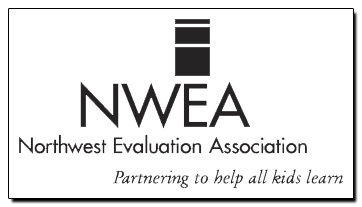
About NWEA
NWEA is a global not-for-profit educational services organization located in Portland, Oregon. The NWEA's mission is partnering to help all kids learn. NWEA works with over 3,500 educational organizations worldwide to provide research-based adaptive assessments, professional development, and research services. As a result of NWEA tests, educators can make informed decisions to promote academic growth.
FAQ's
What different assessments does the NWEA offer?
Measures of Academic Progress (MAP) – These computerized tests are adaptive and offered in Reading and Mathematics. When taking a MAP test, the difficulty of each question is based on how well a student answers all the previous questions. As the student answers correctly, questions become more difficult. If the student answers incorrectly, the questions become easier. In an optimal test, a student answers approximately half the items correctly and half incorrectly. The final score is an estimate of the student’s achievement level.
When will my child be tested and how often?
Students in grades Kindergarten-5 will be tested three times a school year. Additionally, grades 6-8 will be tested two times a school year.
How long does it take to complete a test?
Although the tests are not timed, it usually takes students less than one hour to complete each MAP test.
Do all students in the same grade take the same test?
No. MAP assessments are designed to target a student’s academic performance in mathematics and reading. These tests are tailored to an individual's current achievement level. This gives each student a fair opportunity to show what he or she knows and can do.
What are NWEA assessments used for?
The NWEA assessments help teachers better target their students’ strengths and weaknesses. Not only does it highlight these areas but it provides important feedback on growth in these specific areas.
Important Terms
Below are a few of the terms you may hear and use as you are talk with teachers and your children about MAP scores and reports.
District Average - the average RIT score for all students in the school district in the same grade who were tested at the same time as your child.
Norm Group Average - the average score of students who were in the same grade and tested in the same term as observed in the latest NWEA study.
Percentile Range - percentiles are used to compare one student’s performance to that of the norm group. Percentile means the student scored as well as, or better than, that percent of students taking the test in his/her grade. There is about a 68 percent chance that a student’s percentile ranking would fall within this range if the student tested again relatively soon.
Percentile Rank - the percentile rank is a normative statistic that indicates how well a student performed in comparison to the students in the norm group. The most recent NWEA norm sample was a group of over 2.8 million students from across the United States. A student’s percentile rank indicates that the student scored as well as, or better than, the percent of students in the norm group. In other words, a student with a percentile rank of 72 scored as well as, or better than 72 percent of the students in the norm group.
RIT - tests developed by NWEA use a scale called RIT to measure student achievement and growth. RIT stands for Rasch UNIT, which is a measurement scale developed to simplify the interpretation of test scores. The RIT score relates directly to the curriculum scale in each subject area. It is an equal-interval scale, like feet and inches, so scores can be added together to calculate accurate class or school averages. RIT scores range from about 100 to 300. Students typically start at the 180 to 200 level in the third grade and progress to the 220 to 260 level by high school. RIT scores make it possible to follow a student’s educational growth from year to year.
RIT to Reading Range or Reading Range - the RIT to Reading Range or Reading Range is a score (displayed as a 150 point range) resulting from a correlation between NWEA's RIT score and the MetaMetrics Lexile scale. It can be used to find text of appropriate difficulty. The RIT to Reading Range or Reading Range is included on several MAP reports and allows educators and parents to find appropriately challenging books, periodicals, and other reading material for students.
The RIT to Reading Range or Reading Range represents a level of reading difficulty that leaves readers neither frustrated nor bored. Text in this range should stimulate a student to new learning while rewarding their current reading abilities.
Standards - standards are statements, developed by states or districts, of what students should know and be able to do, related to specific academic areas.
*The information above was provided by www.NWEA.org